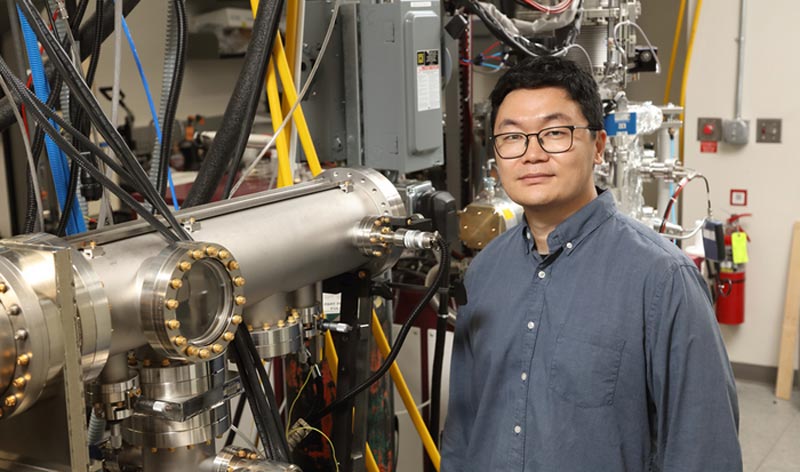

Kyusang Lee in his Thin-Film Device Lab at the University of Virginia School of Engineering and Applied Science.
Credit: UVA School of Engineering and Applied Science
Project aims to understand — and use — this quasiparticle’s role in next-gen optoelectronics.
In the U.S. military, the use of sensors can make the difference between life or death and success or failure on the battlefield. In everyday life, sensors perform indispensable roles in our health, safety and security.
Optoelectronic sensors — those that use the physics of light particles to interact with electrons to produce a beautiful TV picture, allow a soldier to see at night or detect invisible radiation — rely on semiconductor materials to operate. The quest for optoelectronics with improved performance and new functionalities lies in finding new non-silicon semiconductors that can expand current capabilities.
Kyusang Lee, an assistant professor of electrical and computer engineering and materials science and engineering at the University of Virginia School of Engineering and Applied Science, is already known for integrating innovative processes to develop semiconductors with customizable properties. Now, Lee has received a prestigious award from the Air Force Office of Scientific Research to investigate promising new semiconductor material systems.
His approach involves building a “mixed-dimensional heterostructure” — that is, joining together 2D and 3D semiconductor materials using the techniques he has pioneered over the past several years. A material system engineered this way has the potential to efficiently detect a wide range of frequencies on the electromagnetic spectrum, including ultraviolet, visible and infrared light, in which the Air Force is interested, Lee said.
Before he can tap that potential, he needs to understand the optical and electronic properties of the heterostructure — specifically, how electrical charges and energy move across the 2D-3D junction through a “hybrid charge transfer exciton.”
Excitons are quasiparticles — meaning they are not true particles like photons, electrons and neutrons — with their own functional properties, one of which is the ability to transport energy without a net electric charge. Excitons are already widely used in everyday products, such as cell phone displays and TVs. But the key to fully exploiting their capabilities is a comprehensive understanding of their underlying science.
Lee’s first task under the three-year, $450,000 Young Investigator Research Program award is to describe the quantum physics — or the atomic-level mechanisms — of his proposed heterojunctions based on various existing semiconductor materials. To accomplish this, he will develop a theoretical model predicting the behavior of the excitons across these junctions.
The project’s next phase calls for fabricating the mixed-dimensional heterostructures, which he’ll use to validate or modify his quantum model predictions. What Lee learns about excitonic energy can eventually be applied to design a wide array of optoelectronic sensing technologies.
What he expects to find is that the excitons’ natural properties as an energy carrier, combined with the characteristics of his mixed-dimensional heterostructures, will result in highly energy-efficient systems that are very good at detecting and emitting light to cover broad regions on the electromagnetic spectrum.
“By using this engineered structure, which is not naturally existing, I believe we can efficiently tune and utilize these excitons,” Lee said. “I’m trying to find engineered structures and physical mechanisms using the combination of 2D and 3D materials that can utilize these excitons for general-purpose optoelectronic devices. That is the key scope of the project.”
Chief advantages of Lee’s heterostructures, and the processes he will use to build them, are energy-efficiency and cost savings to make the next-generation optoelectronic devices more affordable. Those pioneering semiconductor synthesis techniques — called remote epitaxy, 2D-layer transfer and layer-resolved splitting — have been chronicled in Nature, Nature Nanotechnology, Science Advances and other journals.
Lee earned his bachelor’s and master’s degrees at Korea University and Johns Hopkins University, respectively, and his Ph.D. in electrical engineering and computer science at the University of Michigan. He began working on remote epitaxy — a way of growing a crystalline semiconductor material on a substrate — and coupling 2D and 3D structures as a postdoctoral associate in the mechanical engineering department at the Massachusetts Institute of Technology.
The Air Force award is not Lee’s first young-investigator award since arriving at UVA. In 2020, he received the National Science Foundation’s CAREER Award for a project to engineer the equivalent of a human eye that also uses his synthesis techniques.
Much of Lee’s research revolves around fundamental science, but it’s the link between science and technology that drives him — the hope to see his research eventually translated into products.
His research could be far-reaching, says Scott Acton, chair of the Charles L. Brown Department of Electrical and Computer Engineering at UVA.
“Kyusang’s research on excitons has the potential to make better transistors, the building block of the computer, to make more efficient solar cells, to unravel mysteries of quantum computing, and to improve imaging,” Acton said.
Media Contact
Jennifer McManamay
University of Virginia School of Engineering and Applied Science
jmcmanamay@virginia.edu
Office: 540-241-4002









![[1] Key Research Findings on Transfer-Printed Alumina–Gold Dual-layer Protective Coating](https://www.innovations-report.com/wp-content/uploads/2025/07/Transfer_printing_technology_for_lithium_protectiv_1753252750-e1753252940671-362x245.jpg)


